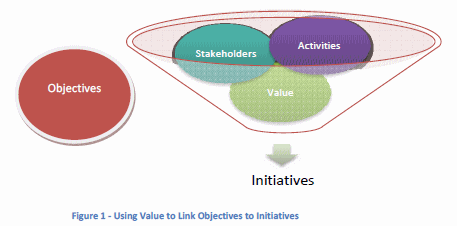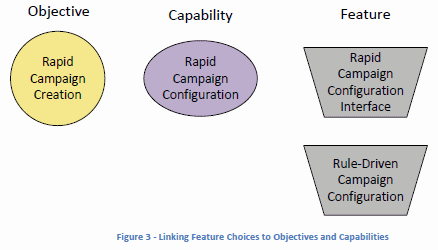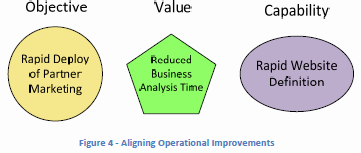Leveraging Business Architecture for a Business Analysis Practice
If you have not already heard the term “Business Architecture” you are part of a rapidly shrinking population. Business Architecture is something that has people abuzz in organizations across the world. Much of the discussion involves corporate strategy and how to provide governance structures. Business Architecture is all about making it possible for organizations to gain the visibility that allows them to better align themselves to pursue their organizational objectives. At some level everyone in an organization is impacted by higher level organizational initiatives. For those whose role does not involve these kinds of higher level organizational efforts you might wonder if Business Architecture has any relevance to you. The answer is yes it does! To understand the relevance you first have to step back a bit an examine the organization that you are part of.
Motivation and Value Because organizations are a human creation it should not be too surprising that they themselves behave a lot like a person would. An organization has ideas of what it wants to do and makes plans for itself. But like any person, an organization’s plans are just that… plans. What the organization actually does is seldom exactly what was planned for because things outside of its control keep changing and not too surprisingly the organization’s objectives change too.
Managing an organization with a changing set of objectives is one of the key challenges that leadership faces. Gaining alignment is difficult during the best of times but constantly adjusting that alignment is something that most organizations have been unable to tackle. Almost everyone has lived through some organizational initiative that was forgotten long before it was ever fully adopted by the organization. This kind of misalignment has a significant cost to organizations both in wasted effort on those initiatives as well as in the lost opportunity to get the value that a better aligned organization can deliver. Of course organizations and people are different in many ways. Organizations have external stakeholders which have specific benefits that they derive from interacting with the organization. These benefits form the core of what is usually referred to as “value analysis”. Value analysis examines the

activities being performed within an organization in relationship to the value that an external stakeholder gains from the activity. One of the key activities within Business Architecture is create explicit linkages between an organization’s objectives and the initiatives that it is pursuing. Examining the value being delivered to stakeholders and the activities that deliver that value is a key way of gaining the alignment that organizations need. This discipline has profound implications for most areas of an organization and an organization’s business analysis practice is no exception.
Business Analysis and Strategic Advantage How value is created can be evaluated at various levels within an organization. The highest level of contribution to an organization comes when a role delivers value directly to some external stakeholder in one of the organization’s core value streams. Because a business analysis practice operates primarily in the business automation space it may seem like a stretch to think of the business analyst as playing a role in product innovation but that is far from the truth.
By now almost all products at virtually all organizations are intertwined with automation technology of some kind. For many organizations the technology is no longer just a way of more efficiently supporting the business’s products and services. The change that has happened over the last 10 years in the travel industry is a good example of this. While online reservations once were seen as just a channel extension of the existing business they are now part of the core business. Delivering superior automation solutions has been a key battlefield in this industry. The battle has now moved to providing automated ways of creating packages, finding fare combination that reflect different objectives, providing loyalty‐based offerings and partnering to deliver promotional offerings that provide differentiation. In short, the competitive advantage of the travel industry has become driven by an organization’s ability to leverage technology.
For organizations where automation‐based business offerings are a key area of competition a business analysis practice can be a key player. In this role business analysis acts in a product design role by helping shape requirements into a cohesively designed automation solution. For example, a hotel management organization might be looking to roll out a new marketing campaign on their website that is geared towards promoting longer stays by offering a 4th night free to loyalty program members at a certain level. Designing a solution to this problem involves much more than simply defining a way to expose the promotion on a website.
For many organizations speed‐of‐innovation is a key need because it allows an organization to be the first to deliver a new market differentiator. From a business analysis standpoint knowing that the objective is to quickly deploy a solution is essential to enabling the business analysis practice be able to adapt the organization’s development lifecycle to support this speed of innovation. It is also important for the business analysis practice to explore the types of changes that might be needed in the future and identify when investment in a generic capability can contribute to an identified value. In the hotel case the business analysis practice might identify that the speed of delivery of loyalty‐driven campaigns could be increased by creating a generic capability to adapt campaigns based upon customer characteristics. By working with the marketing area the business analysis practice could determine if personalized campaigns were a key differentiator that should be pursued. This kind of alignment and feedback between the business analysis practice and other business areas is key aspect of how business architecture relates to a business analysis practice.
Business Analysis and Process Innovation Contributing directly to an organization’s core value streams is an essential aspect of any business analysis practice. However, for many organizations this kind of opportunity is relatively limited. Does that mean that Business Architecture has an equally limited impact on a business analysis practice? Not at all.
For most organizations the core work that business analysts are asked to perform involves making changes to existing automation solutions. These changes can be driven by a variety of business imperatives: new or modified products, regulatory changes or internal drivers such as cost/timeliness/quality. Because these changes are not directly tied to a change in value to an external stakeholder these kinds of initiatives often are not evaluated using the kind of value‐based approach discussed earlier. However, these kinds of projects represent a much more significant portion of most organizations’ business automation budget than is used by the more strategic projects. Because of this the opportunity for gaining business benefit from creating better alignment is substantial.
One of the most common issues of misalignment involves the cost of a business automation solution. There is a wealth of data that supports the idea that the largest cost of a business automation solution is the ongoing operations maintenance. In spite of this, most organizations do not require a rigorous analysis of the ongoing operational costs that a solution will incur. One organization found that the ongoing cost of a newly implemented business automation solution was so much higher than the cost of the system that it was replacing that they decided to abandon the new solution.
But cost is not only a matter of ongoing operational expenses. Cost also involves the amount of effort to make changes to the automation solution. Once again, organizations frequently fail to thoroughly identify the change scenarios that an automation solution will need to accommodate. In organizations where the flow of change is constant this oversight can be an enormous issue.
Most organizations that do not do a good job assessing the ongoing cost of a business automation effort cite the additional time and effort that is involved in doing this. This is a false tradeoff but it is hard to

correct this if an organization does not have a solid approach in place to use to assess the situation. A Business Architecture offers support for this by providing a framework that organizations can use to evaluate the tradeoffs that exist in these kinds of projects. By providing visibility into the tradeoffs it becomes possible for organizations to gain a communal awareness of the issues and make informed tradeoffs.
This Business Architecture‐driven framework involves some of the elements we have touched upon earlier: Objectives and Capabilities. These two elements provide the general structure for making decisions but at this level the details of the tradeoffs require an additional element: the Feature. Features are specific characteristics that a business automation solution will possess. Features are things like: a behavior, an appearance or information. For the purposes of a business analysis practice features are things that represent choices between ways to achieve the requirements of a particular initiative. So a feature might be to create a marketing campaign interface that allows a certain range of campaign configurations to be rapidly defined. An alternative might be a rule‐driven approach which allows a broader range of campaigns to be configured but with more complexity. Defining these alternatives in terms of the objectives associated with the larger scale programs that an organization is pursuing allows these tradeoffs to become visible and can build consensus around whatever approach is chosen.

Sometimes the choices involve a request for funding the building of an automation facility which does not currently exist and whose benefit is not expected to be fully realized within a particular project. Business Architecture refers to these kinds of facilities as a “capability”. These capabilities represent a range of behaviors that an organization might be able to perform based upon the new business automation facility. When an organization identifies a new potential capability it is implicitly asking an organization to make an investment choice. That investment choice involves understanding how that capability will be leveraged across any number of initiatives in order to provide a return on the investment that is required. The business analysis practice has a role to play in identifying situations where a capability might be able to be leveraged and working with various business operations groups to identify if the value of investing in the creation of that capability is sufficient across a range of initiatives for it to be considered as an investment target.
Business Analysis and Operational Improvement While improving an organization’s value proposition attracts the lion’s share of interest actually running the existing organization consumes that largest part of an organization’s time and resources. Because of this defining what it means to run an organization well is something that there has an inordinate amount of effort spent on. Approaches like Lean and Six Sigma have created extensive bodies of knowledge focused on techniques for optimizing operations. Business analysis practices typically straddle both worlds having a role supporting operational efforts as well as initiative‐driven efforts. Operational optimization is a never‐ending effort. The business analysis practice which focuses on operational work is likely to see significant pressure from the business to find a way to reduce its efforts to further optimize the ongoing operations. Business analysis as a practice is highly personnel intensive and most organizations find that the skill‐set demands for senior business analysts are increasingly difficult to staff. The answer to this problem is for organizations to move to standardize business analysis practices and align technology solutions more closely to these practices to help reduce the amount of business analyst labor required and to more effectively leverage the scarce and expensive senior business analyst resources.
Business Architecture might seem out of place in a discussion around operations since it is primarily focused on supporting initiatives rather than operations. But decisions about how to support engaging a business analysis practice must be driven by and aligned with organizational objectives if they are to be effective. In fact, the decision about where to invest in creating standardized approaches for a business analysis engagement is another example of a concept that we have touched upon earlier. Each standardized engagement pattern is an example of a capability that the business analysis practice can develop. As discussed earlier, any decision about creating a capability is a decision to make an investment in creating the capability in order to enable some desired business behavior. Determining what kind of capability should be created requires aligning to the business objectives. This can be done by understanding both what new initiatives the business is pursuing as well as by understanding the historical patterns of change that are expected to continue in the future.

For our travel example, the organization has targeted as an objective the ability to perform a “Rapid Deploy of Partner Marketing”. Analysis of existing processes within the business analysis practice has indicated that the amount of time it takes to agree upon the web‐store layout for new marketing initiatives is a major barrier to speed‐to‐market. The business analysis practice lead has done some investigation and has determined that they can develop a capability within the business analysis practice that will allow them to deliver “Reduced Business Analysis Time”. This capability is a pattern for business analysis that the organization calls “Rapid Website Definition”. In order to have this capability the business analysis practice will need to invest in training and tooling for a certain set of business analysts that will be targeted to support this specialized business analysis engagement pattern.
The Role of the Business Analysis Practice A business analysis practice is a key organizational asset that organizations are looking to better leverage. One of the key ways that a business analysis practice lead can help assure that their organization is delivering what their business partners need is to adopt a business architecture approach.
Central to this approach is to make explicit the value proposition for the business analysis practice. When doing this one of the key things to avoid is the assumption that a business analysis practice is homogeneous. A mature business analysis practice will adopt patterns of engagement that are tailored to support specific business objectives. In this kind of environment the business analysis practice may engage in a product designer role; a process innovation role; or may simply support operational activities.
By moving upstream in an organization’s value flow a business analysis practice can increase the value it delivers to an organization. In addition, by avoiding the focus on operational activities that contribute cost it is possible for a business analysis practice to address the demands for higher output and efficiencies while providing a growth path for the practice as a whole and the individuals within it.

















